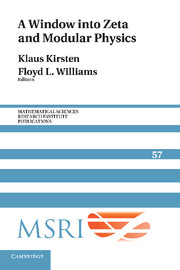Book contents
- Frontmatter
- Contents
- Introduction
- Lectures on zeta functions, L-functions and modular forms with some physical applications
- Basic zeta functions and some applications in physics
- Zeta functions and chaos
- Vertex operators and modular forms
- Applications of elliptic and theta functions to Friedmann–Robertson–Lemaître–Walker cosmology with cosmological constant
- Integrable systems and 2D gravitation: How a soliton illuminates a black hole
- Functional determinants in higher dimensions using contour integrals
- The role of the Patterson–Selberg zeta function of a hyperbolic cylinder in three-dimensional gravity with a negative cosmological constant
Functional determinants in higher dimensions using contour integrals
Published online by Cambridge University Press: 29 May 2025
- Frontmatter
- Contents
- Introduction
- Lectures on zeta functions, L-functions and modular forms with some physical applications
- Basic zeta functions and some applications in physics
- Zeta functions and chaos
- Vertex operators and modular forms
- Applications of elliptic and theta functions to Friedmann–Robertson–Lemaître–Walker cosmology with cosmological constant
- Integrable systems and 2D gravitation: How a soliton illuminates a black hole
- Functional determinants in higher dimensions using contour integrals
- The role of the Patterson–Selberg zeta function of a hyperbolic cylinder in three-dimensional gravity with a negative cosmological constant
Summary
ABSTRACT. In this contribution we first summarize how contour integration methods can be used to derive closed formulae for functional determinants of ordinary differential operators. We then generalize our considerations to partial differential operators. Examples are used to show that also in higher dimensions closed answers can be obtained as long as the eigenvalues of the differential operators are determined by transcendental equations. Examples considered comprise of the finite temperature Casimir effect on a ball and the functional determinant of the Laplacian on a two-dimensional torus.
1. Introduction
Functional determinants of second-order differential operators are of great importance in many different fields. In physics, functional determinants provide the one-loop approximation to quantum field theories in the path integral formulation [21; 48]. In mathematics they describe the analytical torsion of a manifold [47].
Although there are various ways to evaluate functional determinants, the zeta function scheme seems to be the most elegant technique to use [9; 16; 17; 31]. This is the method introduced by Ray and Singer to define analytical torsion [47]. In physics its origin goes back to ambiguities in dimensional regularization when applied to quantum field theory in curved spacetime [11; 29].
For many second-order ordinary differential operators surprisingly simple answers can be given. The determinants for these situations have been related to boundary values of solutions of the operators, see, e.g., [8; 10; 12; 22; 23; 26; 36; 39; 40]. Recently, these results have been rederived with a simple and accessible method which uses contour integration techniques [33; 34; 35]. The main advantage of this approach is that it can be easily applied to general kinds of boundary conditions [35] and also to cases where the operator has zero modes [34; 35]; see also [37; 38; 42]. Equally important, for some higher dimensional situations the task of finding functional determinants remains feasible. Once again closed answers can be found but compared to one dimension technicalities are significantly more involved [13; 14]. It is the aim of this article to choose specific higher dimensional examples where technical problems remain somewhat confined. The intention is to illustrate that also for higher dimensional situations closed answers can be obtained which are easily evaluated numerically.
Information
- Type
- Chapter
- Information
- A Window into Zeta and Modular Physics , pp. 307 - 328Publisher: Cambridge University PressPrint publication year: 2010
Accessibility standard: Unknown
Why this information is here
This section outlines the accessibility features of this content - including support for screen readers, full keyboard navigation and high-contrast display options. This may not be relevant for you.Accessibility Information
- 1
- Cited by
